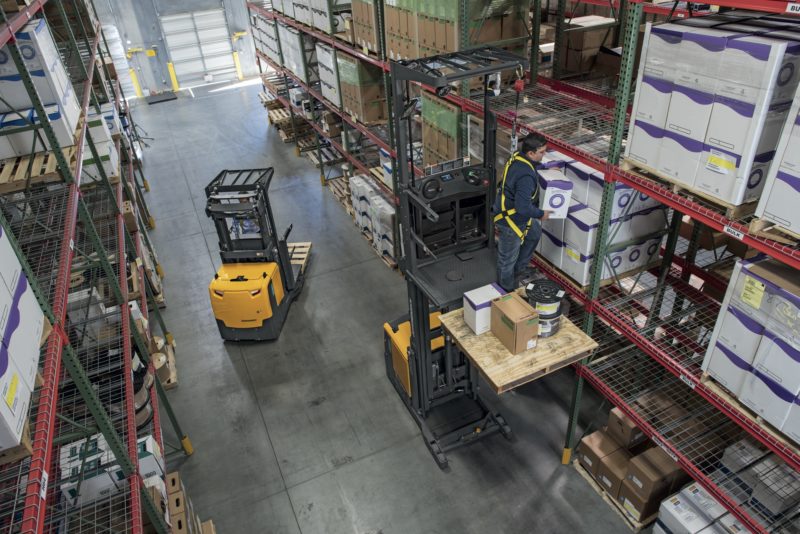Ways to Streamline Processes by Using a Warehouse Order Picker

Because today’s consumers have become increasingly accustomed to receiving their goods extremely fast, businesses of all sizes – from mom-and-pop shops to large corporations – need to streamline their order picking practices in order to deliver products in the most efficient manner possible. This is especially true for enterprises that rely on warehouse staff or automated equipment to fulfill orders.
[CUTOFF]So, what exactly does order picking entail?
Order picking is essentially the labor required to pull an item from inventory to fulfill a customer’s order. While this may seem like an easy procedure, you might be surprised to learn that an average of 55 percent of operational costs in distribution centers are focused on order picking. In other words, warehouses with ineffective systems could halt further innovation, stunting company growth. On the flip side, when you successfully streamline your business’s order picking methodology, you can offer faster fulfillment times to your customers, promote accuracy in your orders, minimize costs, and much more. Keep reading as we delve into how to strategically approach order picking and some of the best warehouse order picker practices for improving productivity in your facility.
Types of Order Picking Strategies
While every organization has its own unique fulfillment requirements, there are some popular frameworks that exist that you can use as a guide when customizing your own order picking strategy, which are outlined below.
Zone Picking
Zone picking is used when a warehouse is compiling orders that contain multiple components and to reduce walk times for pickers. The inventory is arranged into “zones” where each warehouse order picker deals only with the unique SKUs found in their zone.
Discrete Picking
With discrete picking, the order picker doesn’t have their own zone. Instead, they gather each piece of inventory for every order, one item at a time. This strategy is better suited for small warehouses that don’t have to put together complex orders.
Cluster Picking
Efficiency is the main goal of cluster picking, as it involves a single order picker compiling multiple orders at a time, typically dealing with several different SKUs. This method is faster by nature, but it leaves room for more errors if you don’t have the proper resources.
Wave Picking
Wave picking is a strategy designed specifically for warehouses that handle a diverse inventory along with high fulfillment demand. This strategy requires a single picker to prepare each order, but instead of the orders being fulfilled according to what number they are in line, they are assessed so that they can be prioritized by time and importance. This enables companies to ship out goods in waves, hence the strategy’s name.
Batch Picking
Batch picking is essentially where managers assess their inventory to determine the placement of it. The idea is to place more popular items towards the front of the warehouse (for easy accessibility) and the less popular goods towards the back. This works well for e-commerce businesses that have somewhat predictable ordering patterns.
It is important to note that you are not limited to only one of these order picking strategies. In fact, many businesses choose to combine two or more of the above picking types to better suit their needs.
Best Practices for Improving Warehouse Productivity
Because order picking is a crucial function of any warehouse operation, it is important that you use the right picking strategies and tactics. Also, be sure to leverage the right technology and industrial machines to streamline your processes and optimize workflows. Doing these things will not only improve your staff’s productivity but will ultimately contribute to a better bottom line. Some key methods for improving warehouse productivity include:
Designing your warehouse layout for optimal flow
Each functional station of your warehouse should be positioned to flow from one activity to the next. You will want to design the layout based on how inventory flows through each area, from receiving to outbound shipment. This logical flow can prevent staff members from having to double-back across various stations to fulfill an order.
Zoning fast-moving SKUs together
Smart warehouse managers usually leverage the 80/20 rule, which states that 20 percent of products make up 80 percent of customers’ orders. With this knowledge, managers can zone high-volume SKUs to optimize order picking activities, similar to the batch picking method previously discussed. This reduces travel time for a warehouse order picker because they no longer need to travel throughout the entire warehouse to retrieve popular goods.
Ensuring the safety of your order pickers
Pickers and packers must handle goods that have been handled by other associates within your warehouse. Under the current COVID-19-induced circumstances, this can put your employees at risk. To combat this, warehouse managers should consider solutions like redesigning their pick zones and using better technology. This works to both ensure the safety of your staff members while also allowing your business to meet consumer demands in the most efficient manner possible.
Because companies vary so widely in terms of products, facility sizes, and workforce capabilities, there is no one-size-fits-all approach to order picking. While there are some basic best practices that managers should employ in any warehouse, weeding through all the strategic options and combinations isn’t quite as easy. Are you a little lost when it comes to determining the best picking strategy for your facility? Let Darr Equipment help. Our top-notch warehouse solutions help you fully customize your warehouse layout and design, set up and install racking and shelving, and pair the right machines with your layout to maximize productivity. Contact us today to get started.